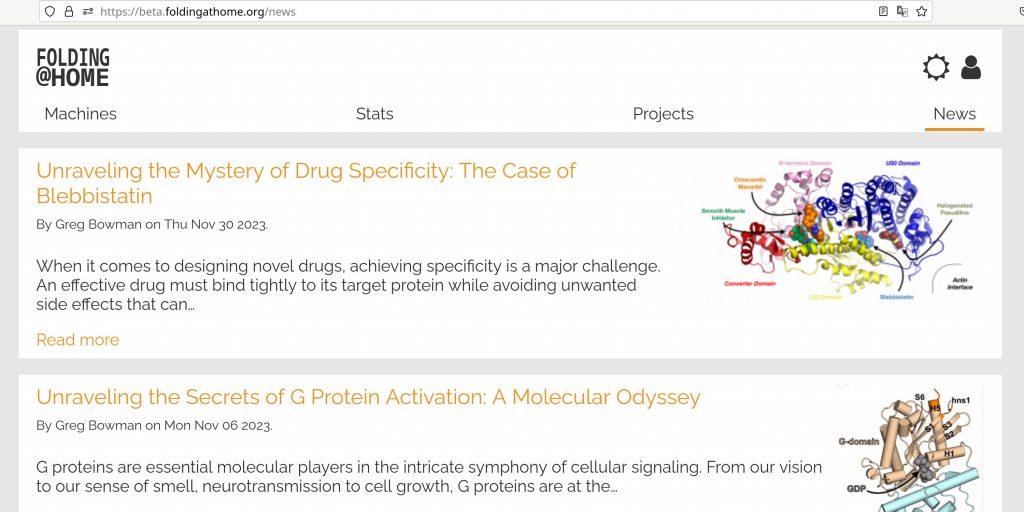V8.3 Client Guide
Introduction to V8.3 (Bastet)

We are excited to announce version 8.3 of the Folding@home software. V8 has been code named “Bastet” in reference to the Ancient Egyptian goddess who is associated with cats and protection from disease.
V8 is a complete rewrite of the Folding@home client software designed to make using Folding@home easier, lay a foundation for new features and to encourage community participation in the software’s continued development.
What’s New in V8.3?
There are several important changes between V7 and V8.3. First, there are now only two parts to the client software: the backend (fah-client-bastet) which runs behind the scenes handling most of the logic of running Folding@home, and the frontend (fah-web-client-bastet) Web Control which provides the user interface. The v8 backend is equivalent to FAHClient in v7. The v8 Web Control combines the features of the v7 Web Control, FAHControl and FAHViewer.
Second, the concept of folding slots in v7 has changed in v8.3. Instead of configuring slots, you only have to tell Folding@home which compute resources (e.g. CPUs and GPUs) you would like it to use. It will then automatically allocate those resources in the most efficient way. This change both simplifies the setup of Folding@home and makes it possible for Folding@home to allocate multiple CPUs and GPUs to the same Work Unit. By allocating more resources to a single WU, Folding@home can decrease simulation times and achieve scientific results more quickly.
Finally, the advanced interface FAHControl from v7 is no longer a separate application. The new Web Control integrates all of the capabilities of FAHControl and more. V8.3’s Web Control, in combination with a Folding@home account, makes it possible to monitor and control all of the machines you have contributing to F@H from any browser or smartphone no matter where those machines are located.
Differences between earlier v8 versions
If you participated in the v8.1 beta or v8.2 alpha, there are a few changes you should be aware of. The peers feature is no longer available. Use the more powerful folding account feature instead. Resource groups first appeared in v8.1 then disappeared in v8.2 and came back in v8.3. If you tried all of these versions, there may be some mix-ups with your configuration. See the change logs for more details.
Downloading the Software
The v8.3 client is now the official Folding@home client software. You can download it from the main software download page. You can still download the older v7 releases on the v7 download page.
Installation
The v8 client can run on Windows, macOS, Linux and ARM Linux. The install procedure for v8 is essentially the same as for the v7 client, with the exception that on Linux you now only need to install the fah-client package. V8 specific install instructions have yet to be written. For now, please consult to the v7 install guides.
Using the V8.3 Software without a Folding@home Account
The v8.3 Folding@home software is controlled via a web browser using Web Control. Web Control can be reached by navigating to https://v8-3.foldingathome.org/. From this page your browser will attempt to connect to client software running on the same computer the browser is running on.


If you have installed Folding@home v8.3 and it is running then the local machine should appear on the “Machines” page after a short delay. Note, v8.3 Web Control cannot be used with v8.2 or older clients.
Using the v8.3 Software with a Folding@home Account
Creating and logging into your Folding@home account makes it possible to control and configure all your Folding machines from anywhere, including from your smartphone.

To register for a Folding@home account, you must provide a valid email address and choose a passphrase. Please note, a passkey is not the same as a passphrase. You can use Web Control to generate a good passphrase for you by clicking the button. It will choose four random words as your passphrase. No numbers or special characters are required. This is very secure and easy to remember. To see the passphrase, click the button. Otherwise, click the button to copy the passphrase to the clipboard.
If your local client is configured, your Username, Team and Passkey will auto fill. These last three fields are not required. After you click the Register button, an email will be sent to the address provided. Clicking on the link in this email will activate your account.
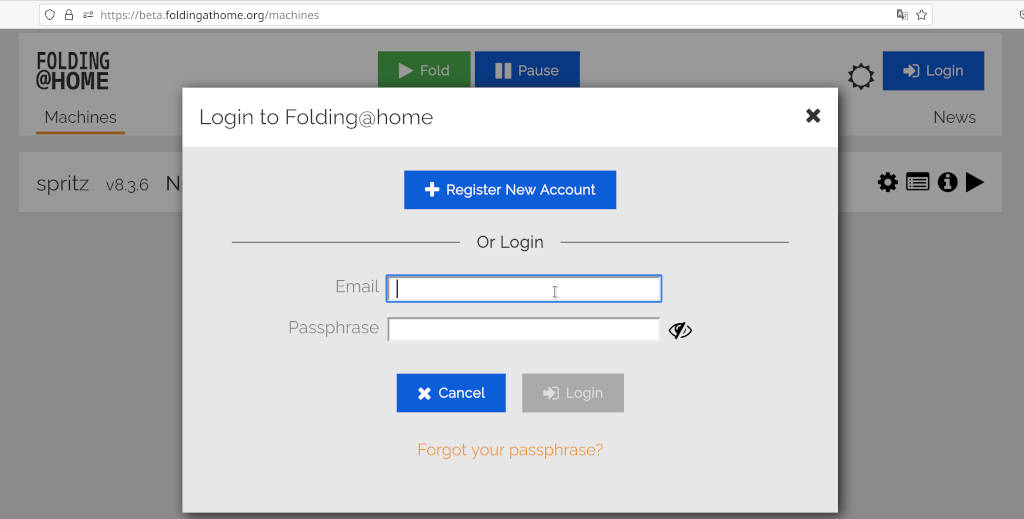
Once logged in you will be able to access your account settings by clicking the user icon in the top right and all the machines connected to your account will appear on the machines page.
Account Settings
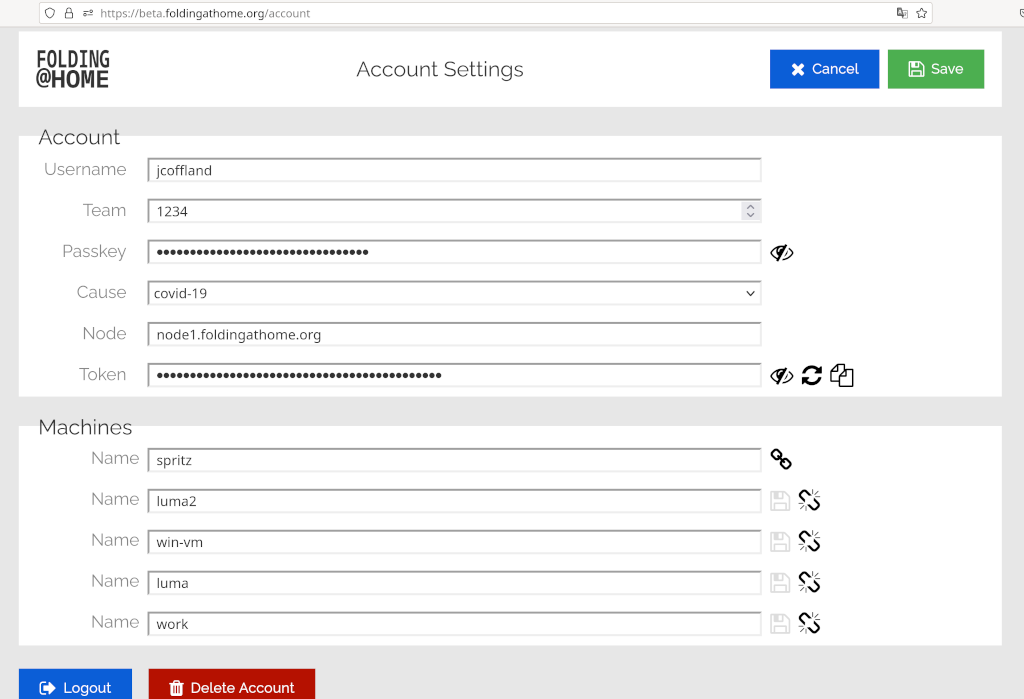
In the Account section you can set your Username, Team and Passkey. These settings affect how you receive Folding@home points. More information about these settings and the points system can be found in the FAQ.
Choose a Cause preference to tell Folding@home which cause you’d like to support the most. Folding@home will try to assign more projects supporting your preferred cause but it is not guaranteed that you will get only these projects.
Node and Token affect how your machines connect to your Folding@home account. More information about these can be found below.
For your changes to take effect, you must click the ![]() button in the top right. Or click
button in the top right. Or click ![]() to discard unwanted changes.
to discard unwanted changes.
Use Machines section to rename machines or connect and disconnect them from your account. These settings take affect immediately after the corresponding button is clicked. Warning: disconnecting a machine will make it inaccessible from your account and it will have to be reconnected manually.
Connecting Machines to your Account
Folding machines can be connected to your account either automatically or manually. When a v8.3 machine is running locally and it is not already connected to another Folding@home account, it will be automatically connected if you login to your account using a browser on the same machine. So just install v8.3, login once to your account and you’re good to go. Manually connecting machines may be necessary if the local machine is already connected to another account. You can change its connection using the link icon in the Account Settings.
Manually Connecting Machines
For machines without a graphical user interface, a.k.a. headless machines, you will need to connect manually using the current account token. You can copy the account from your account settings using any browser. Then pass the account token using the account-token configuration option in the config.xml configuration file and restarting the client. You can also use the machine-name option to give the machine a recognizable display name.
After using the account token, it is recommended that you change it. This prevents others from adding machines to your account should they gain access to your account token. Only the most recent account token can be used to add machines to your account, so keep it secret but change it after you’re done connecting a new batch of machines.
The account node will be set automatically to something like node1.foldingathome.org. It is rather complicated but it is possible to run your own node. See the fah-node project for more information.
Machines Page
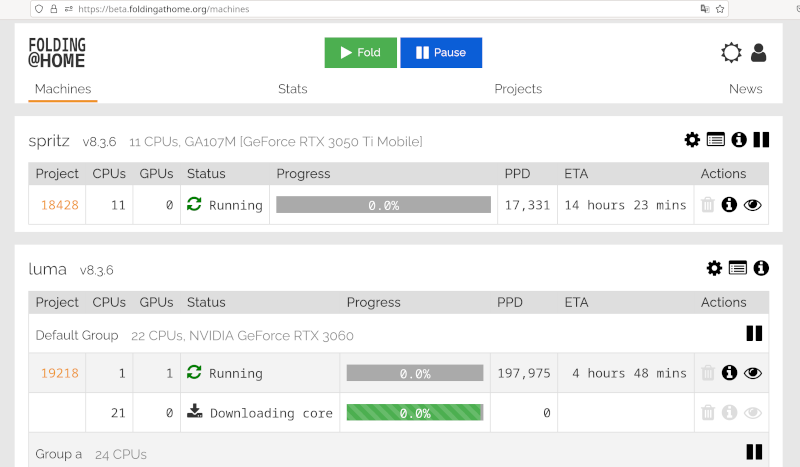
The machines page is the first screen you will encounter. After connecting, it will display the status of your local F@H machine or all your account’s machines if you are logged in.
In the header are two large buttons, Fold and Pause. Clicking Fold will start folding on all your machines. If you are just getting started with F@H you may want to first configure your Folding user name and team.
In the body of the page is a list of your machines and any active Work Units. Work Units or WUs are chunks of protein folding simulations. They represent the work assigned to your machines. Here you will find the status and progress for each WU. On the right are several buttons. These can be used to dump the WU or view it’s details or 3D visualization. You should only dump WUs in exceptional situations.
Machine Settings
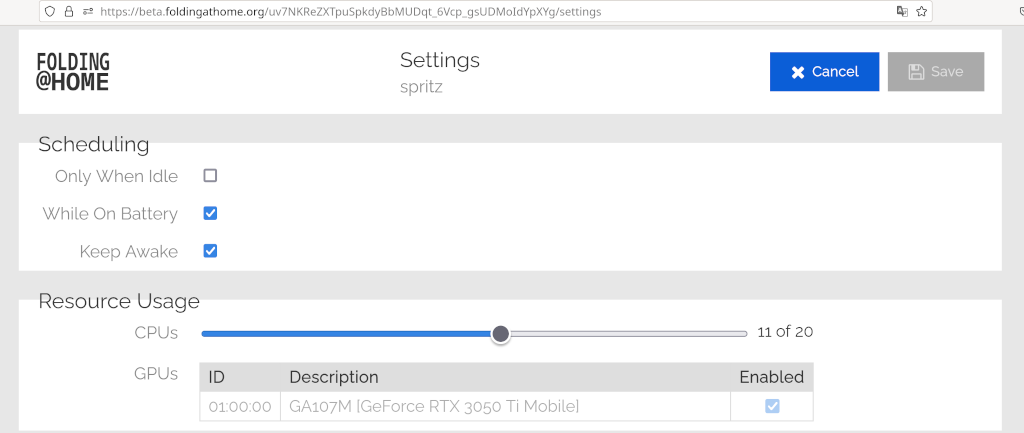
Note: the machine settings page will include the machine’s account settings if you are not logged in. Otherwise, account settings are set globally via the account settings page.
Scheduling
These settings affect when folding runs. Only When Idle causes the machine to only fold when the machine is idle. I.e. when no one is moving the mouse or typing on the keyboard. When enabled, While On Battery allows folding to occur on machines like a laptop when they are not plugged in. Keep Awake will cause Folding@home to prevent your machine from going to sleep and thus continue folding when not on battery.
Resource Usage
In this section, you can tell Folding@home how to use your compute resources.
The CPUs slider can be used to set the number of CPU cores Folding@home uses. You can adjust this value at any time. Setting the value too low may cause some WUs to stop running.
In the GPUs section you will find a list of the supported Graphics Processing Units available on your machine. GPU folding is the most efficient and usually earns much higher points. In some cases, folding on the GPU can slow your machine down too much. You can always disable GPU folding here. More information about GPU folding can be found in the FAQ.
Advanced
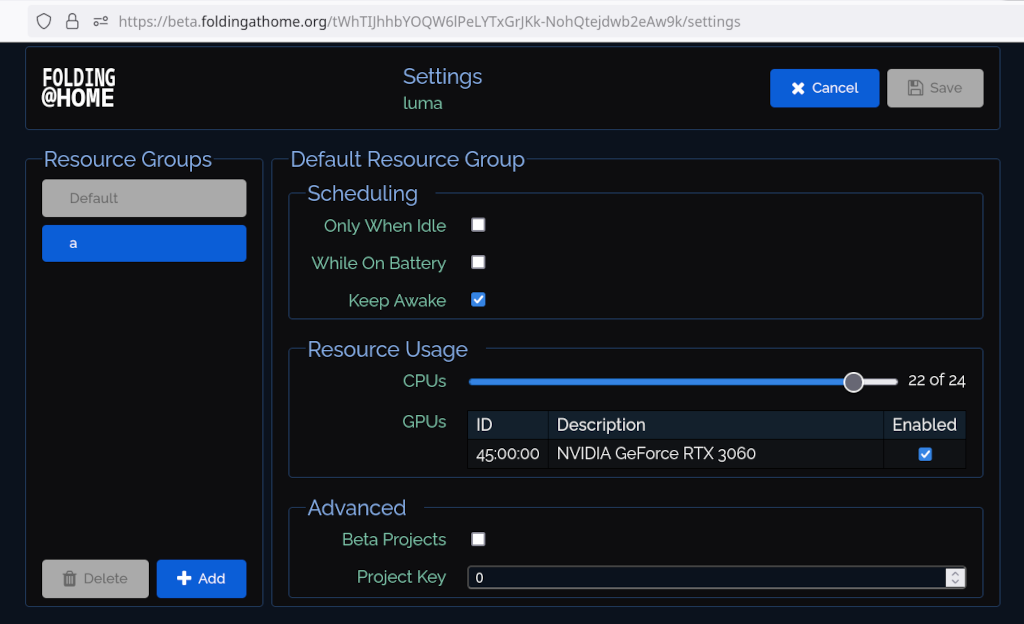
Some advanced settings can be unlocked by clicking the small lock icon in the bottom right of the machine settings screen. Once advanced settings are unlocked, this icon disappears. These settings are mainly used for testing Folding@home software and simulation projects.
In the Advanced section you can enable Beta Projects. This will allow your machine to be assigned projects which are in testing. In some cases, this can result in earning less points. A Project Key is used for restricting assignment to a particular project only. Your machine will not be able to get any other project than the one that matches the key if this key is set to something other than zero.
Resource Groups can be used to split up your compute resources into multiple groups which each can have different settings. This is usually used in combination with a Project Key to test a particular type of Folding project. With resource groups it is possible to over-allocate your resources, which can lead to poor performance and could bog down your machine making it unusable. Experts only, use with caution.
Stats Page
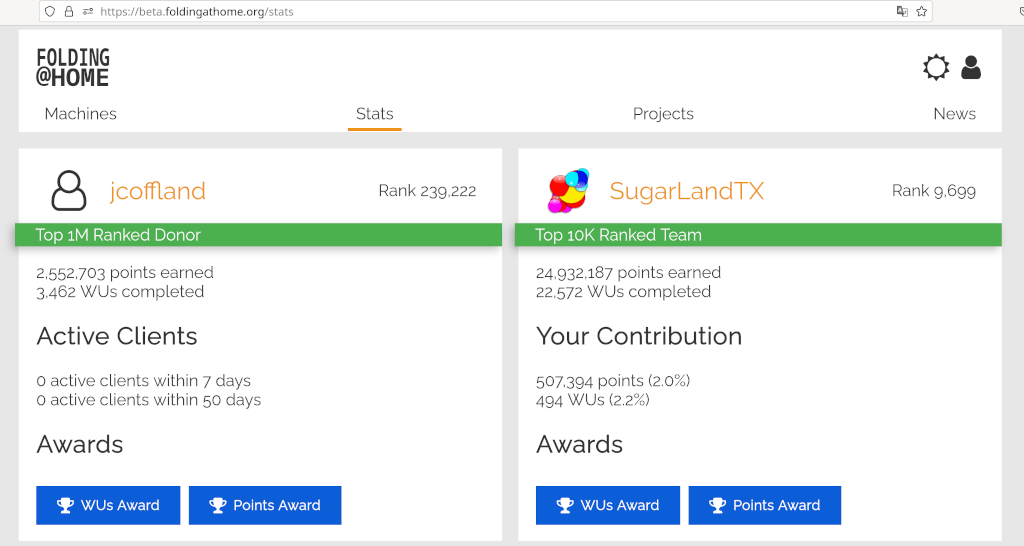
The stats page shows you and your team’s points and ranking. You can also download award certificates commemorating your contribution milestones.
Projects and News Pages
The projects page shows information about the projects your machines are currently folding. The page is empty if you are not actively folding. On the news page you can see a list of recent Folding@home blog posts.
Log Viewer
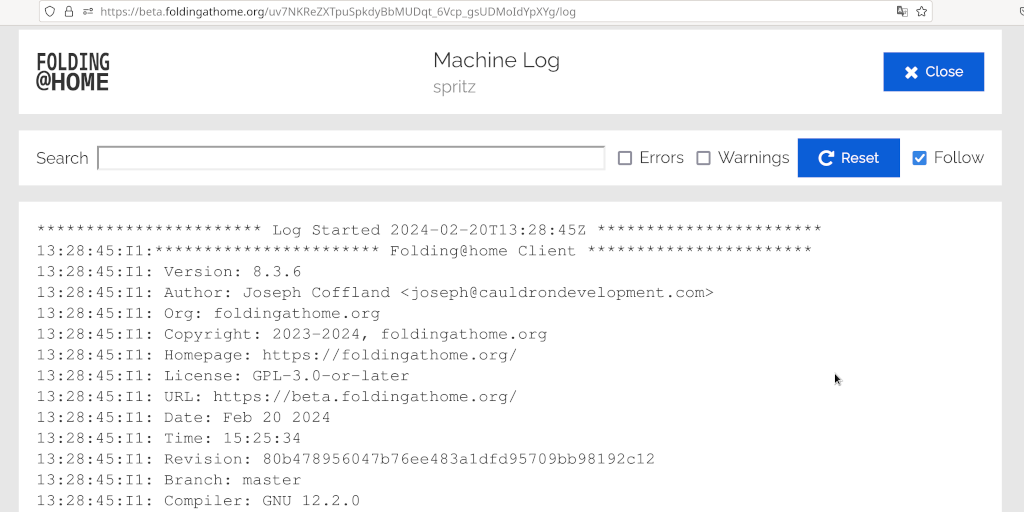
The Log Viewer allows you to view detailed technical information about the folding simulations running on your machines. Making sense of these logs requires expert knowledge of the Folding@home software. If you encounter a problem with F@H you may be asked to share the contents of this log file.
The Search bar can be used to filter the log for matching lines. Checking the Errors or Warnings boxes will filter the log for error and warning messages. The Reset button resets the log filters to their defaults. When Follow is enabled the log file will automatically scroll down as new information becomes available.
3D Protein Viewer

The protein viewer displays a 3D view of the protein you are simulating. The 3D view can be accessed by clicking on the icon on the right side of each Work Unit’s row on the machines page. You can zoom with the mouse wheel and rotate the protein by moving the mouse while holding the left button down.
There are three different modes for viewing the protein. These can be changed by clicking on the 1, 2 and 3 buttons. As the simulation progresses it will take snapshots of the protein. You can cycle through these snapshots or Frames by clicking the arrow buttons. If no frames are yet available this screen will show 0 of 0 frames.
Dark Mode
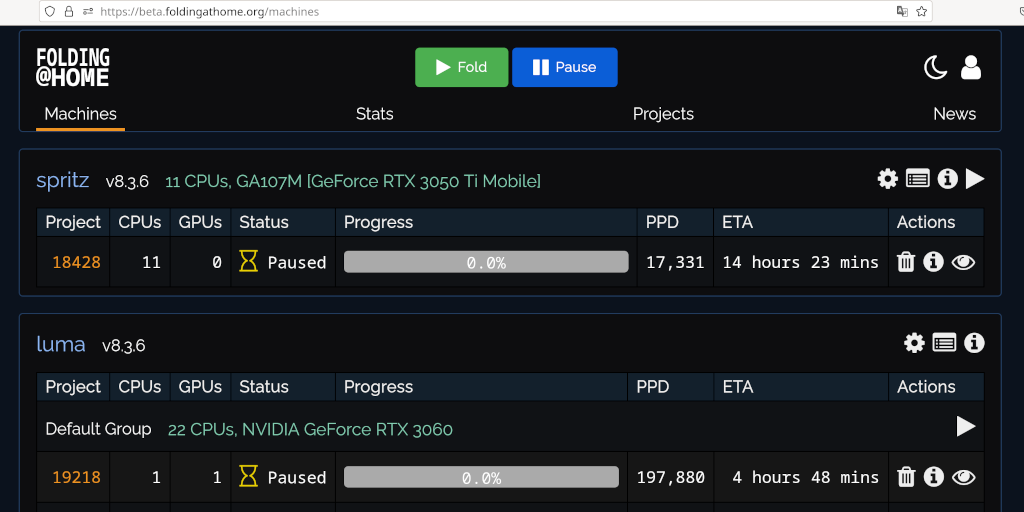
You can also switch between dark and light modes using the sun/moon icon in the top right corner. Some people may find dark mode more visually pleasing and easier on the eyes in low light.
Getting Help
If you need more help with Folding@home:
- Visit the Support Page
- Ask questions at Folding Forum
- Browse previously reported issues on GitHub at fah-client-bastet or fah-web-client-bastet.
Open-Source Contribution
The v8 Folding@home client software is Open-Source. Anyone can get involved in improving Folding@home via our GitHub account. You can report issues, suggest new features or contribute code by visiting the v8 client’s GitHub repositories:
Only submit new issues on GitHub if you’ve fully researched the problem, gathered all the relevant information and checked that the issue does not already exist. We get many requests for new features. We can only afford to implement some of them. Ask for help before creating your first GitHub issue.
You can submit your own changes to the Folding@home software via a GitHub Pull Request (PR). PRs are much more likely to be accepted if they are simple and the code is clean and well tested.


